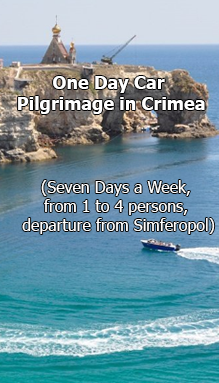Priest-Martyr Clement of Rome Inkerman Monastery
| Status: | active monastery | |
| It was founded in VIII–IX c. (a cave monastery). It became deserted after the Turkish invasion of 1475. In XVII–XVIII c. there is mentioned the Cave Temple of the Great Martyr George, after 1778 the Monastery became finally deserted. It was revived in 1852. The temples were being built in the name of: 1852 — St. Clement, 1867 — St. Martinian, 1895 — the Great Martyr Panteleimon, 1905 — the Great Martyr Demetrius of Thessalonica, St. Nicholas the Wonderworker and the Icon of the Mother of God “Consolation of All Who Sorrow”. From 1920 all the temples became parochial ones, gradually, to 1931 they were closed. In 1992 the revival of the monastery started. | ||
| Sacred objects and relics: | The particle of the holy relics of the Sainted Hierarch Clement | |
| Location: | The City of Sevastopol, Inkerman, near the ruins of the ancient fortress of Kalamita | |
The Monastery history
In one of the most picturesque places of Crimea not far from Sevastopol on the bank of the Chornaya River, falling into the North Bay, in the ancient cave town of Kalamita there is Inkerman Moastery in the name of Priest-Martyr Clement. The place is closely connected with the origins of the Christianity. Here in I c. St. Clement used to work. Here in VII c. St. Bishop Martin was exiled.
In VI c. the Byzantians founded here the Fortress of Kalamita, and later in VIII–IX c. in the rock above the Fortress there started to make cave premises, churches and monastic cells, where there settled down the iconodule monks from Byzantium, persecuted during the period of iconoclasm. The ruins of the Fortress are still preserved to the present.
After the invasion in XIII c. of the Tartars to the peninsula, the Christians of Crimea were suffering hard times, and from the end of XV c., when the capital of the Orthodox Byzantium — Constantinople — fell, in Crimea Islam became the predominant religion. Many monasteries and temples were ruined.
Inkerman Monastery started to restore one of the first in 1852 by the efforts of the canonized in 1997 Sainted Hierarch Innocent (Borisov). The ancient church in the name of St. Clement, made in the rock, became the first active temple of the Monastery. The legend says that this most ancient of the cave churches of Inkerman was made with the hands of St. Clement himself. In its main elements the Temple imitated the architecture of the ground-based churches.
St. Clement Inkerman Monastery
The Crimean War which started in 1853 prevented the Monastery from restoration. The Monastery turned out to be in the centre of the awful events — not far from it in 1854 there was the Battle of Inkerman, which is called by the contemporaries “the Golgotha of the Russian Army”. After seven hour battle thousands of people died here. The ancient cave church suffered as well — a new iconostasis and the door were pierced with bullets, and in one of the walls there lodged a cannon ball.
After the war the brethren’s building and the house for visitors were built, a part of the monastic cells were allocated in the old caves. In 1867 near the Temple of St. Clement the second temple was made — in the name of St. Martin with the sepulchers hewed in the walls and the floor. In a cozy Monastery yard with a small garden under the protection of a gilded cross the fountain used to spout.
In 1907 on Inkerman Rock in memory of the Crimean War the large St. Nicholas Cathedral was built. Before the October Revolution seven churches were functioning in the Monastery.
From 1926 in the Inkerman Monastery they started to close the Monastery churches, and the cave temple was given to the museum. During the Sevastopol Defense of 1941–1942 many ground-based Monastery structures were ruined, however the cave temples were preserved. At that time in the Monastery caves there were the headquarters of the 25th Chapaev Rifle Division.
The Monastery was reopened with the blessing of the current Archiereus Most Eminent Lazarus in 1992. Nowadays in the ancient church the services are conducted again, the father superior’s house and brethren’s building have been restored, the cemetery is being put in order. And now one can see the tunnel corridor hewed by the medieval monks in the strata of the rock massif leading to three ancient cave temples in the name of: St. Martin the Confessor, St. Apostle Andrew the First-Called and to the central Monastery basilica temple, bearing the name of the priest-martyr. In the Monastery there are kept the particles of the holy relics of the Precious Head of the Priest-Martyr Clement, given from the Kiev-Pecherskaya Laura. The hermitage of the Saviour is being restored near the Village of Ternovka near Sevastopol.
The Inkerman Monastery was literally restored from the ruins by Archimandrite Augustine (Polovetskiy). On September 13th 1996 Father Augustine and Hieromonach Agapitus (Malanich) died in the road accident. For his comparatively short life Father Augustine restored not only several Crimean temples, but saved many people, helped to bare their soul. Hieromonach Agapitus, close co-worker and assistant with Father Augustine, tried to follow his example in everything. The dead are buried on the territory of the Inkerman St. Clement Monastery.












